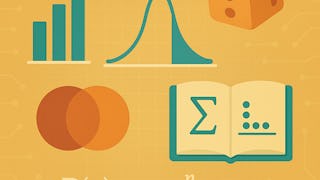This course offers students an opportunity to learn fundamentals of computation required to understand and analyze real world data. The course helps students to work with modern data structures, apply data cleaning and data wrangling operations. The course covers conceptual and practical applications of probability and distribution, cluster analysis, text analysis and time series analysis.

Unlock access to 10,000+ courses with Coursera Plus. Start 7-Day free trial.

Skills you'll gain
Details to know

Add to your LinkedIn profile
1 quiz, 3 assignments
See how employees at top companies are mastering in-demand skills

There are 4 modules in this course
In this module, we will focus on Python programming fundamentals. The aim is to help understand Python's basic syntax, data types, and operators, enabling the creation of simple programs. Additionally, we will cover the use of if statements, loops, and proper indentation to control program flow, fostering a foundational understanding of essential control structures in Python programming.
What's included
5 videos7 readings1 assignment1 programming assignment1 discussion prompt
In this module, we will dive into the diverse landscape of Python data structures, including lists, dictionaries, sets, tuples, and arrays. By exploring real-world use cases, you will uncover the unique strengths and weaknesses of each data structure. You will gain insights into recognizing and understanding the characteristics of these structures, empowering you to make informed choices when tackling programming challenges. Through hands-on practice, you will develop the skills to select and apply the most suitable data structure to efficiently solve a wide range of problems, enhancing your proficiency in Python programming.
What's included
2 videos3 readings1 quiz1 programming assignment
In this module we will introduce DataFrames, a pivotal tool in data manipulation and analysis. You will grasp the fundamental concepts of DataFrames, learning how to create, manipulate, and access data efficiently. You will gain essential skills for basic data exploration–including summarizing data, indexing, and slicing, enabling them to extract meaningful insights. Furthermore, this module equips learners with the expertise to clean and preprocess data, covering handling missing values, filtering data, merging/joining datasets, and transforming data for analysis readiness. By the end of this module, you will harness DataFrames for advanced data analysis, mastering group-wise operations, aggregation, and statistical analysis.
What's included
3 videos4 readings1 assignment1 programming assignment
This module will equip you with a comprehensive toolkit for proficient data exploration and analysis. It covers the essential techniques and tools for effectively summarizing data sets, encompassing statistical summaries, data visualization, and data cleaning methods. You will learn how to identify and assess missing data, outliers, and anomalies, vital tasks during the initial exploratory phase of data analysis. Furthermore, you will develop the ability to uncover patterns, relationships, and trends within the data using various visualizations, including scatter plots, histograms, and correlation matrices, enabling them to extract valuable insights and make informed decisions from their data.
What's included
2 videos2 readings1 assignment1 programming assignment
Prepare for a degree
Taking this course by Northeastern University may provide you with a preview of the topics, materials and instructors in a related degree program which can help you decide if the topic or university is right for you.
Instructor

Offered by
Explore more from Data Analysis
 Status: Preview
Status: PreviewNortheastern University
 Status: Free Trial
Status: Free TrialBirla Institute of Technology & Science, Pilani
 Status: Preview
Status: PreviewNortheastern University
 Status: Free Trial
Status: Free TrialUniversity of Pittsburgh
Why people choose Coursera for their career





Open new doors with Coursera Plus
Unlimited access to 10,000+ world-class courses, hands-on projects, and job-ready certificate programs - all included in your subscription
Advance your career with an online degree
Earn a degree from world-class universities - 100% online
Join over 3,400 global companies that choose Coursera for Business
Upskill your employees to excel in the digital economy
Frequently asked questions
To access the course materials, assignments and to earn a Certificate, you will need to purchase the Certificate experience when you enroll in a course. You can try a Free Trial instead, or apply for Financial Aid. The course may offer 'Full Course, No Certificate' instead. This option lets you see all course materials, submit required assessments, and get a final grade. This also means that you will not be able to purchase a Certificate experience.
When you purchase a Certificate you get access to all course materials, including graded assignments. Upon completing the course, your electronic Certificate will be added to your Accomplishments page - from there, you can print your Certificate or add it to your LinkedIn profile.
Yes. In select learning programs, you can apply for financial aid or a scholarship if you can’t afford the enrollment fee. If fin aid or scholarship is available for your learning program selection, you’ll find a link to apply on the description page.
More questions
Financial aid available,

